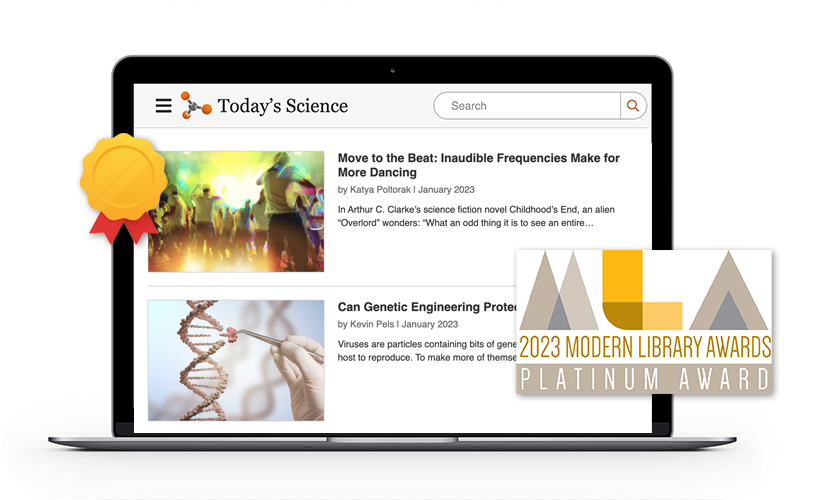Today’s Science Brings Home the Platinum Modern Library Award

Ask any scientist what they know about platinum, and they’d tell you that it’s a dense but malleable precious silver-white metal with a high melting point. They may even know its chemical symbol (Pt) and atomic number (78). But thanks to LibraryWorks’ ninth annual Modern Library Awards (MLAs), Platinum is also the distinction awarded to Today’s Science—which has been helping students think like scientists since 1992.
This esteemed distinction is not easy to come by. Today’s Science was reviewed by 80,000 library professionals who assessed the essential STEM database for its quality, functionality, value, customer service experience, and overall satisfaction. On a scale of 1 to 10—with 1 being “least satisfied” and 10 “most satisfied”—Today’s Science scored an impressive 8.53. “We have received overwhelmingly positive feedback from librarians and teachers after adding Infobase’s Science Online and Today’s Science to our statewide resource collection,” one judge commented. “The platforms are easy to navigate, and the content fills the previously unmet need for high-quality science resources.”
A Bridge Between the Classroom and the World
Today’s Science bridges the gap between the science taught in class and real-world discoveries—giving in-depth explanations of important advances in biology, chemistry, the environment, space, physics, and technology in accessible, easy-to-understand language. The original articles, researched using peer-reviewed journals and other authoritative sources, offer easy access to related content such as crossword puzzles, cartoons, and discussion questions; additional articles that help place news and discoveries in context; and interviews with working scientists that bring their research to life. An extensive backfile dating back to 1992 illustrates how one scientific advance leads to another; the stories focus on the questions scientists ask themselves and, in doing so, reinforce science educators’ traditional emphasis on the scientific method.
This curriculum-oriented science resource shows how the scientific method can be applied to everyday life to help students think like scientists. Plus, the fully responsive design, intuitive navigation, easy access to key content, eye-catching images, and other features make Today’s Science an efficient, effective, and user-friendly experience.
Highlights include:
- High-Interest Science News Articles: More than 6,000 original articles, written in easy-to-understand language, highlight the most important advances in fields such as anthropology (including archaeology), astronomy and space, biology, chemistry, Earth science, the environment, mathematics, medicine and health, physics, psychology, science and society, and technology. Each article includes stunning videos, images, and diagrams that give students a front-row seat in a virtual scientific amphitheater.
- “Need a Research Topic?” Today’s Science includes summaries of key topics, with links to related articles to help jump-start student research.
- Conversations with Scientists: A unique feature, Today’s Science includes more than 800 engaging and insightful Q&As with today’s leading scientists across virtually every field of science. Each Q&A includes a brief introduction, including a synopsis of the scientist’s career development, academic affiliations, and awards and achievements. The articles explore the how and why of the scientists’ research as well as their perspective on the latest developments in their field and the career paths that they followed to achieve their goals. In-text links are provided to related articles, associations, and institutions. These articles also serve as primary source documents.
- Glossary of Key Terms and Convenient Pop-Up Glossary: An extensive glossary of key scientific terms and principles in an A-to-Z index as well as pop-up definitions throughout the database promote science literacy.
- Editorial Cartoons & Questions: Hundreds of editorial cartoons chosen specifically to support and illustrate scientific principles engage students in critical thinking.
- Crossword Puzzles: Hundreds of original, interactive crossword puzzles help students learn and retain the key scientific terms and concepts used in Today’s Science news articles. The crossword puzzles are also available in a printable format.
- Educator and Student Tools: Assignments and research tools are included to help students speak—and educators teach—about science.
- Video News Briefs: Extending its coverage of breaking science news, Today’s Science features hundreds of Science Video News Briefs, with more added weekly—using engaging, real-world examples to teach applied science.
- Extensive Article Topic Index: Whether students are looking for the latest developments in various topic areas such as immunology, green energy, human behavior, or El Niño, Today’s Science’s full, hyperlinked list of topics provides easy and quick access to the entire scope of STEM.
- Extensive Backfile and 30,000+ embedded hyperlinks to related articles illustrate how one scientific advance leads to another.
- Impressive Visuals: 20,000+ eye-catching and illuminating images, photographs, diagrams, and charts pique student interest.
- Discussion Questions that encourage critical thinking are included with each article.
- Year in Science: Every January, Today’s Science releases a summary of major events in science news from throughout the previous year, complete with links to related articles, discussion questions, and more.
- Authoritative Sources: Articles in Today’s Science are expertly researched and written by scientists and science journalists, and distilled from major scientific journals and news sources for content researchers and instructors can trust.
What is Science Hub?
Science Hub is an all-in-one resource that offers comprehensive content across core scientific disciplines alongside up-to-date news, discoveries, interactive experiments, and expert insights—supporting STEM instruction and research, critical thinking, and information literacy.